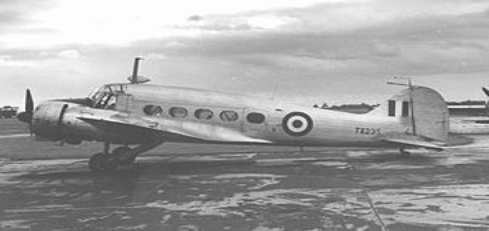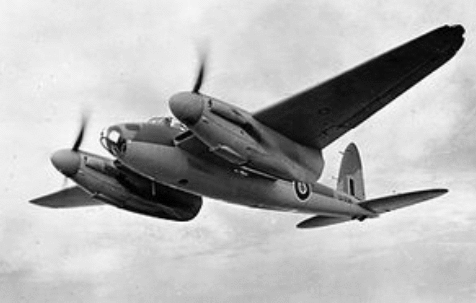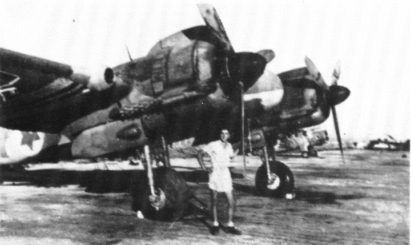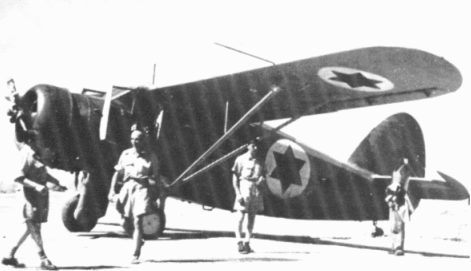
On the advice of British pilots John Harvey, Freddy Fredkins and Joe Sutherland, who had flying experience on Ansons, Emanuel Tzur, a Haganah agent, purchased five Avro Ansons in Europe, and Tzur then decided to continue his operations in the U.K.
Unfortunately, the five aircraft remained impounded in Greece until January 1949, two aircraft in Athens, and three on Rhodes Island. A Dutch pilot, William Van Leer, was refueling at Rhodes, and instead of using an international voucher to pay, he paid in cash as he had a large amount of dollars with him. As this was an out-of-the-way airfield, the Greek who had refueled the plane had never seen so many dollars in his life, so he rushed into town and the story soon spread. When the Greek Government officials heard the story they were pressurized by the British Consul to impound the three planes in Rhodes, as well as the two Ansons still at Athens. The Ansons had passed through Rome on April 10th, 1948, on their way to Israel.
Early in January 1949, Air Force Headquarters sent two South African Machal flight engineers, Syd Chalmers and Norman Isaacs, as well as South African Machal pilot Rolfe Futerman, to Athens and Rhodes to repair and test-fly the Ansons before sending pilots to fly the aircraft to Israel.
The two planes in Athens were truly in a bad state. Every piece of movable equipment had been taken away, the engines and fuel tanks were damaged, and even the doors had been removed. The Machalniks learned that British agents had sabotaged the planes. It took some time for the three Air Force personnel to put things together. Fortunately, with their experience in the Israel Air Force in fitting bomb-racks on Dakotas, the Machalniks were able to assist the Greek Air Force engineers in fitting bomb-racks to their Dakotas. As Greece was in the midst of a civil war at the time, the Dakotas were used for bombing Communist rebels in the mountains. Previously, the Greeks had rolled the bombs out through the doors, in the hope they would hit the rebel hide-outs.
The Greek Air Force chief engineer was so grateful to the Machalniks for their help that in exchange he provided several Greek mechanics to help the Machal trio, and within a week Rolfe Futerman was able to test-fly the first Anson.
The three planes at Rhodes were in reasonably good condition, and eventually all five were ready to fly. It was an exciting day at Ramat David Air Base when they got the message that all five Ansons from Athens and Rhodes were on their way.
Mosquito Fighter Bombers
 After just a few days in the U.K., Tzur was able to purchase a Mosquito aircraft for £4,500, and he registered the aircraft in the name of British Machalnik John Harvey. With proper authorization from the British Air Ministry to fly the aircraft, Harvey took off with the intention of flying to Israel via Ajaccio in Corsica, and Athens. However, whilst still flying over the U.K., he was forced to land because of a serious fuel leak. On landing he was placed under arrest and the plane was grounded, but with the intervention of Tzur he was allowed to take off again.
After just a few days in the U.K., Tzur was able to purchase a Mosquito aircraft for £4,500, and he registered the aircraft in the name of British Machalnik John Harvey. With proper authorization from the British Air Ministry to fly the aircraft, Harvey took off with the intention of flying to Israel via Ajaccio in Corsica, and Athens. However, whilst still flying over the U.K., he was forced to land because of a serious fuel leak. On landing he was placed under arrest and the plane was grounded, but with the intervention of Tzur he was allowed to take off again.
On landing at Ajaccio, the British Consul for Corsica had somehow got wind of this flight, and he approached the police to enquire what a British light bomber was doing there. As the police and the airport manager were all sympathetic to Israel, Harvey was airborne by the time the consul arrived at the airport. The consul was told by the airport officials that no aircraft had landed, and after he could not find the aircraft he left, and thus Harvey was able to return, and after repairs and refueling, he continued his planned flight to Israel.
On approaching the Israeli coast, Harvey found that his tank was leaking again, and so he decided to shorten his flight and land at Haifa Airport. His flight was unexpected, so as he came in for landing he was fired on by Israel anti-aircraft guns. Luckily he evaded the fire, and as the plane came to a halt, he was surrounded by armed airport guards. Speaking in English, Harvey was finally able to convince them that he was a friend and not an enemy.
Bristol Beaufighter Bombers TF-10
 In August 1948, at about the same time that John Harvey had flown the Mosquito out of England, Emanuel Tzur purchased seven Beaufighters in scrap condition from a second-hand aircraft merchant for £1,500 each. Meanwhile, having returned to the U.K. from Israel, Harvey had purchased a second Mosquito and had hired a pilot to fly the plane to Israel. Unfortunately, on take-off from Ajaccio where he refueled, the pilot crashed the aircraft, but he emerged unharmed.
In August 1948, at about the same time that John Harvey had flown the Mosquito out of England, Emanuel Tzur purchased seven Beaufighters in scrap condition from a second-hand aircraft merchant for £1,500 each. Meanwhile, having returned to the U.K. from Israel, Harvey had purchased a second Mosquito and had hired a pilot to fly the plane to Israel. Unfortunately, on take-off from Ajaccio where he refueled, the pilot crashed the aircraft, but he emerged unharmed.
This crash attracted the attention of the British press, and the pilot was required to appear before the British Aviation Council, where he received a warning against any further excursions of this nature.
In the meantime, the Beaufighters had been repaired. One of the pilots, whose lady friend was an actress, devised a plan to get the aircraft out of England. A movie company was established, with its first production based on a story of the heroic participation of New Zealand pilots who were stationed in the U.K. during the WW II Battle of Britain. One scene called for the take-off of a flight of Beaufighters, and the flight was authorized by the British Air Ministry.
Five of the seven aircraft were ready for the take-off scene. Unfortunately, on 30th August 1948, just one day prior to the intended take-off, pilot Julian McNeile Verschoyle-Campbell crashed his aircraft during a test-flight and was killed. The crash was of course investigated by the police, but the four remaining planes succeeded in carrying out the plan before the investigation was completed. The planes disappeared over Europe, and reached Israel after refueling at Ajaccio and Athens. The remaining two Beaufighters were impounded in England.
On arrival in Israel, it was discovered that the Beaufighters lacked armaments and spare parts and were not operational. It was therefore necessary for Tzur to find and purchase the missing equipment in the U.K. Then the problem arose as to how to fly the equipment out of England. Once again, John Harvey came to the rescue. John knew the owner of an ex-RAF four-engine Halifax Bomber which had been converted into a civilian cargo carrier, and on behalf of Tzur, he arranged for a charter to Israel.
All went smoothly until the Halifax’s arrival in Israel at night. Ekron airbase remained unresponsive to the plane’s code call, and so the plane was diverted to Sde Dov in Tel Aviv. South African Machalnik Ernest Esakof was on duty at Sde Dov, but no one knew anything about the Halifax. Ernie phoned Smoky Simon, Chief of Air Operations, who also knew nothing about the flight. Having agonized about whether to put on the runway lights, Esakof decided to take the risk and switched them on. The Halifax, piloted by a British pilot, crashed on the runway, ripping off its wheels.
The airfield’s night crew spent hours feverishly removing all the arms and equipment. Next day, a U.N. observer came to inspect the field. The plane was off the runway, seemingly long abandoned there.
On 20th October 1948, in an attack by two Beaufighters of 103 Squadron on the Egyptian-held fortress of Iraq-El-Suweidan, one Beaufighter was shot down. Non-Jewish Canadian pilot Len Fitchett, who had made the Jewish cause his own, together with British navigator Dov Sugarman and an American pilot Stanley Andrews, who had persuaded Fitchett to take him along just for the ride, were all killed in this operation.
Dov Sugarman’s wife Lily, also a British Machalnik, worked in the Operations Department of 103 Squadron. When she saw the faces of the second Beaufighter crew, South African Machalniks Pilot Danny Rosin and Navigator Syd Kentridge, as they entered the operations room without the second crew, she knew immediately that her husband Dov had been lost.
Noordyn Norseman one-engine Light Transport Aircraft
 Although the Ansons Fredkins had helped to locate did not reach Israel until January 1949, he embarked on another project, using a front company called Somaco which was also financed by Van Leer.
Although the Ansons Fredkins had helped to locate did not reach Israel until January 1949, he embarked on another project, using a front company called Somaco which was also financed by Van Leer.
Fifty surplus US Army Norsemen were available for purchase in Europe. These planes were used extensively as transport aircraft during World War II, and would be particularly useful in supplying essential items to isolated kibbutzim in the Negev. In fact, the first three planes had already left Rome on May 2nd 1948, and went into service on the morning after their arrival in Israel, dropping supplies to the encircled Etzion Bloc.
The Norsemen were sturdy Canadian aircraft designed for bush work. Somaco purchased twenty Norsemen, ostensibly for use in the Belgian Congo. All 20 aircraft were to be delivered in Rome by 1st June 1948, and five were delivered in late April.
On May 29th 1948, Canada’s top World War II Ace, George “Buzz” Beurling, together with well-known ex-RAF pilot Leonard Cohen, were practicing take-offs and landings at Urbe Airport near Rome, in preparation for ferrying their Norsemen to Israel. Their plane caught fire in the air, and was engulfed in flames by the time it landed. Both died in the accident. Sabotage was suspected, but never proved.
Three Norsemen, on their flight from Rome to Israel were lost to the Egyptians. Flying in formation, they ran out of fuel in adverse weather conditions, and had to force land in Sinai, with the crews ending-up as prisoners-of-war. The crews were: American pilots Robert Daniel Fine, William Maldive, and Al Trop; Dutch pilot Victor Abraham Wijnberg; and British navigator Hugh Curtiss.
The six pilots who successfully reached Israel were Gino Narboni of France; Freddy Fredkins and Joe Sunderland, both British; and Americans Phil Marmelstein, Max Gordon, and Lou Lenart.
On May 10th on a mission to bomb Beit Machsir, a Norseman piloted by Israeli Yariv Sheinbaum crashed into the side of a hill near Saris. Together with him, co-pilot Daniel Burstein, radio operator Shlomo Cohen, bomb-chuckers Itzhak Shakenowitz, Shlomo Rothstein and Zvi Shusterman, all Israelis, were killed.
In June, the Norseman flights to Israel were discovered by the American Embassy in Paris. This was done by tracing the Norsemen connection to David N. Miller, a former U.S. Army officer who worked as an aircraft broker in Paris. The U.S. Embassy asked the French to ground all aircraft handled by Miller, and revoked his U.S. passport for any travel other than a direct return to the United States. All further deliveries of the planes from Germany were stopped. Therefore, as from 29th October 1948, only five Norsemen were operational in No. 35 Flight, based at Ekron (Tel Nof).

